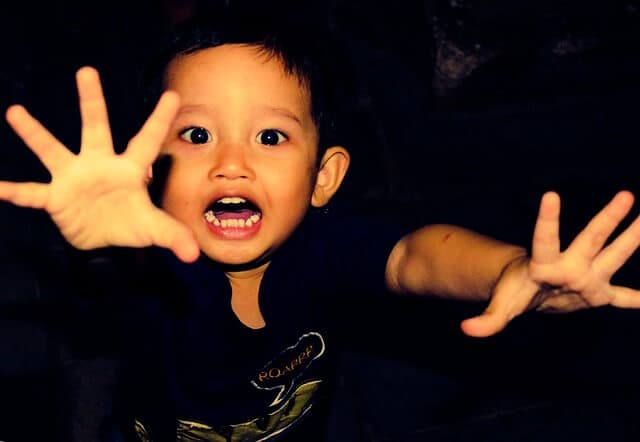Night Terrors: A-to-Z Guide from Diagnosis to Treatment to Prevention

Introduction:
Your little angel wakes up screaming in the middle of the night, calling for his mommy – but his mommy is right there, unrecognized. You try to comfort him, but he shrieks even louder, eyes bulging. He might be having a night terror.
What are they?
Within fifteen minutes of your child’s falling asleep, he will probably enter his deepest sleep of the night. This period of slow wave sleep, or deep non-REM sleep, will typically last from forty-five to seventy-five minutes. At this time, most children will transition to a lighter sleep stage or will wake briefly before returning to sleep. Some children, however, become stuck and are unable to completely emerge from slow wave sleep. Caught between stages, these children experience a period of partial arousal.
Partial arousal states are classified in three categories: 1) sleep walking, 2) confusional arousal, and 3) true sleep terrors. These closely related phenomena are all part of the same spectrum of behavior.
When most people (including the popular press and popular parenting literature) speak of night terrors, they are generally referring to what are called confusional arousals by most pediatric sleep experts.
During these frightening episodes, the child is not dreaming and typically will have no memory of the event afterwards (unlike a nightmare). If any memory persists, it will be a vague feeling of being chased or of being trapped. The event itself seems to be a storm of neural emissions in which the child experiences an intense fight or flight sensation. Once it is finally over, the child usually settles back to quiet sleep without difficulty.
These are very different from nightmares.
True sleep terrors are a more intense form of partial arousal. They are considerably less common than confusional arousals and are seldom described in popular parenting literature. True sleep terrors are primarily a phenomenon of adolescence.
Who gets night terrors?
The tendency toward sleepwalking, confusional arousals, and true sleep terrors often runs in families. They tend to be more common in boys, and are much less common after age 7.
The events are often triggered by sleep deprivation or by the sleep schedule’s shifting irregularly over the preceding few days. A coincidentally timed external stimulus, such as moving a blanket or making a loud noise, can also trigger a partial arousal (which again shows that the event is a sudden neural storm rather than a result of a complicated dream).
What are the symptoms?
Typically, a confusional arousal begins with the child moaning and moving about. It progresses quickly to the child crying out and thrashing wildly. The eyes may be open or closed, and perspiration is common. The child will look confused, upset, or even “possessed” (a description volunteered by many parents). Even if the child does call out his parents’ names, he will not recognize them. He will appear to look right through them, unable to see them. Parental attempts to comfort the child by holding or cuddling often prolong the situation.
Are they contagious?
No.
How long do they last?
Most often, a confusional arousal will last for about ten minutes, although it may be as short as one minute, and it is not unusual for the episode to last for a seemingly eternal forty minutes.
How are night terrors diagnosed?
The diagnosis is based on the history. When a question remains, a physical exam or tests may be run to rule out other possibilities.
How are they treated?
When an event does occur, do not try to wake the child — not because it is dangerous, but because it will tend to prolong the event. It is generally best not to hold or restrain the child, since his subjective experience is one of being held or restrained; he would likely arch his back and struggle all the more.
Instead, try to relax and to verbally comfort the child if possible. Speak slowly, soothingly, and repetitively. Turning on the lights may also be calming. Protect your child from injury by moving furniture and standing between him or her and windows. In most cases, the event will be over in a matter of minutes.
Night terrors can also be treated with medications, hypnotherapy, or with other types of relaxation training if they become a significant problem.
A Novel Approach – The Greene Technique
When my youngest child was going though night terrors, MsGreene observed that he was also “working on” achieving nighttime dryness. In fact, night terrors are most common at the same ages that children are becoming aware of the bladder feeling full during sleep. It dawned on us that perhaps some of these kids just need to go to the bathroom, but are not yet able to wake up fully when their bladders are full. I’ve now treated many kids by having the parents take them to toilet while they’re still asleep. For many of these children, even though they do not recognize their parents, they will often recognize the toilet and urinate. For these children, the episodes stop abruptly and they return to sleep. The calm is dramatic.
How can night terrors be prevented?
Prevention usually involves trying to avoid letting the child get over-tired, and trying to keep the wake/sleep schedule as regular as possible. Taking the child to the bathroom before the parents go to bed can also prevent some night terrors.
Related concepts:
Confusional arousal; Partial arousal state; Sleep terrors.


